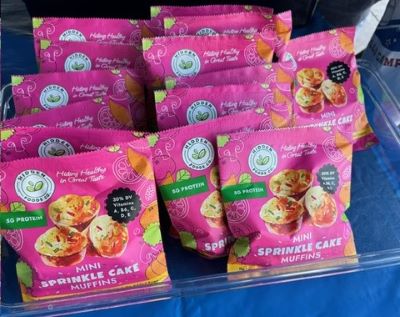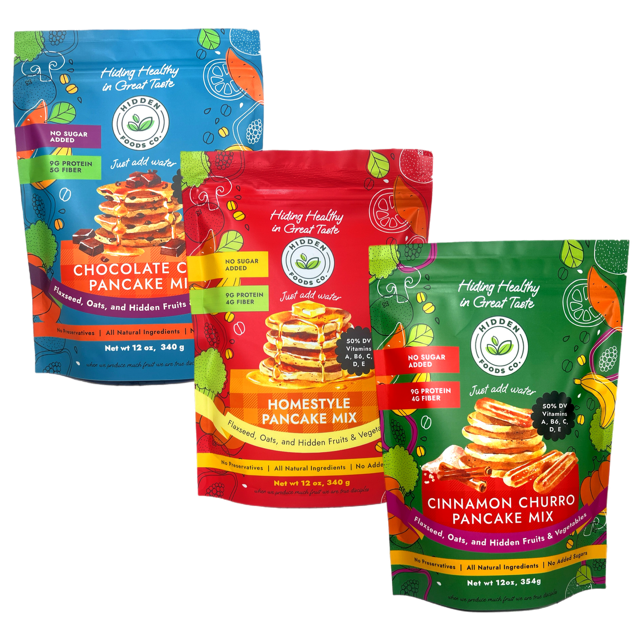Kendra Matthews is on a mission to feed kids better and make mealtime easier for overextended parents. As a busy entrepreneur with two sons, she's got first-hand experience juggling responsibilities and ensuring a proper supper lands on the table.
The founder and CEO of San Diego-based Hidden Foods attributes her passion for food to her Sicilian side. Her father's family has roots in Palermo and Grotte.
She recently took time out to chat about her background and journey to Hidden Foods, the challenges she faced along the way, product offerings, and more.
What is your background?
My dad is fully Sicilian, and my mom is fully English, so I'm about 50/50. It was always a joke between my sister and me: Italian is a huge part of just who we are, and it's this weird pride, even though we're here in America. My mom got us the DNA test, and we said, "We don't want to take it. What if it turns out that we're not?"
So, I had it sitting on my counter for probably two years, and I finally sucked it up and took it. And it came back half Italian (40% Sicilian and the rest from other parts of Italy).
As a Sicilian, besides the fact that we use our hands a lot, cooking ends up being a really big part of my family and who we are. At the table, my kids laugh and say, "Oh, the Sicilians, they all just say mangia!" And I say, "Well, then, mangia, sit, and eat your food."
When I talk to the kids, if we go on a trip, my first question is, "How are you? What did you eat?" Because I think we're constantly trying to feed people, and that is a very strong part of who I am.
Share your journey to Hidden Foods.
Deep down, I'm an entrepreneur at heart. I consider that a sickness because it just doesn't stop. You're just like, "What's the next thing?" It's always been food.
I started with tea, which I was very passionate about. Then, I moved on to cake truffles, which became really popular. Then, I had a macaron company, which kind of led to this.
Baking and sweets and pastries are something that I have always been passionate about, but I have two kids: a 7-year-old and a 10-year-old. My younger one got really picky about eating, and he still is.
I always make homemade sauce. We don't eat anything out of a jar. I make ragù that will sit for a day or two, and then we freeze it, and that's what we eat all year. Those are the things that he liked. It was getting to the point where it was like, "Well, I don't have time, so here's something out of a jar."
It made me feel guilty, so I decided I could do it on my own and bottle it so we could have it. I would also stick some stuff in it to make up for the lack of nutrition that they were getting in other places.
For me, it's about flavor because I want them to shape their palettes. I can give you chicken all day and a piece of broccoli, and I can say, "Yeah, that's really healthy." But if you don't have a variety of foods you're tasting and experiencing, you're not going to grow up to appreciate those different flavors, which I think is a really big deal for an Italian.
The project actually started with ravioli. I had created pasta that had nutritional value in it, so it had some protein, and it had different powdered veggies in it. And then I thought, Well, I can double it up, and then I can put some really good ingredients in the ravioli.
The kids were loving it, they were eating it, and then I coupled it with the sauce and put it all together.
What were some of the challenges you faced?
The manufacturing process for all of this is really hard because once it leaves your kitchen, it's got to go to a really grand scale. You get into this problem where, first of all, you're too small for somebody who has the machinery to be able to do it. Second, when you decide, "Okay, we're going to do that huge gigantic run, and we're going to test it out," some of it just becomes a little complicated. To get the right flavor, it has to cook this way, or it has to do this, and they said, "That's not going to happen. It's going to be all thrown in a pot, and that's just what it is."
So it was kind of a balance to figure out, "Does this work?" I ran into so many roadblocks with it. My husband and I sat down and just said, "Well, let's just start with this sauce and see if we can get that made."
That, in general, was really, really difficult, too, because if you understand anything about products on a grocery shelf, they have to be obviously shelf stable. But in order to do that, they have to maintain a certain pH. When you stick all those healthy vegetables in it, the pH goes through the roof, which is why it's healthy. Typically, tomato sauce is fine because it's got that acidity to it. And if it's all done, the only thing you're worried about is botulism, which is not small, but that can be something you can fix.
We've got pureed beets, carrots, kidney beans, and spinach in there. And so it was really complicated. I talked to a ton of different manufacturing sites, and they all looked at it and said, "Nope, we're not touching that. The pH is way too high."
We ran across somebody who said, "Listen, we'll entertain this." They were able to help me with that one. We actually have five sauces; it's a really big process to get these done.
I don't want to go down the refrigeration road. Our mission is to really make it easier to feed families better. So by having those shelf-stable products, they last longer, and people can take them with them.
After a year, we launched the marinara sauce, and I also had a meat sauce. Our family sauce is really good. But that's been a really big challenge because then the USDA gets involved and wants to tear everything apart, and it has nothing to do with your ingredients. It's solely your label.
I would say "no added sugar" and then "zero added sugar," and they'd say, "No, you can't." Then I'd go back, and they'd say, "Add not a low-calorie food." And I'd say, "Well, it's not really high-calorie, but OK, I'll write that on there." Then you'd submit it, and the next time, they'd come back and say, "Now remove that." I said, "But you told me to put it on there."
After a year, we finally got it approved.
School children are being served Hidden Foods muffins.
Where can we find Hidden Foods?
We're on Amazon and sell through our website. We're in a lot of stores in San Diego, like Seaside Market and Frazier Farms. We're also in some Sprouts down here. We just launched in Lazy Acres up in Los Angeles, and it's kind of a test. Then, we'll branch out to their other stores, just slowly growing that way.
We also have a line that we're working on with the school districts. Again, my goal is really to feed kids better. A lot of their nutrition—in California, especially—comes from the school. So they go in, they have breakfast, and they have lunch. There are also a lot of rules coming down from Sacramento about what these kids can eat—reducing added sugar products and no fake dyes.
We're slotted as a perfect match for the schools. So, right now, we're working with them to make sure we can create some long-lasting, pre-made, and prepackaged products. We just launched some muffins, and so the kids are getting those at school for breakfast.
You've mentioned sauce and muffins. Tell us about your pancakes.
We have four flavors for pancakes. We have homestyle, chocolate chip, cinnamon churro, and gluten-free. All of those include our vegetable blend, so it's essentially your greens for the day, as well as high protein and oat flour, flaxseed, and no added sugar. Those are sweetened with monk fruit and banana powder. You just add water. Again, we're just trying to make it easy for families.
What is your goal with your products?
I'm on a mission to make sure that people are fed better. And how this kind of started was just being so sick of kids having cancer and being sick. The lack of nutrition is so much more than even being physically sick: There are attention deficits and behavior problems and patterns. A lot of that comes from that lack of nutrition. So, my goal was really to feed these kids better. It also needs to be easy because I think parents are saying, "Yeah, I want to feed my kid better, but I'm going for the easier one. I'm going for what's in a jar."
My goal is to partner with moms and say, "We've got your back. Here's some really good stuff, and let's branch out."
I would like this to be everywhere. I want parents to rely on us, trust our brand, and say, "If it's Hidden Foods, it's got to be good. " I know I'm going to give them the nutrition that they need.
So obviously, to get in stores everywhere would be my goal, but also to really break through school districts because I feel that is also something that when it's in front of a kid, they'll eat, and then they move on. And I don't need this to be, "Oh my gosh, this is the best thing I've ever tasted." I mean, I would hope that it is, and I think so. But really, I want them to just eat it and move on. If they don't stop and say, "Oh, what is this? Why is it different?" and they eat it, that is a huge win because of all the nutritional benefits in it.
If you enjoyed this article, consider subscribing to my newsletter for more content and updates!


